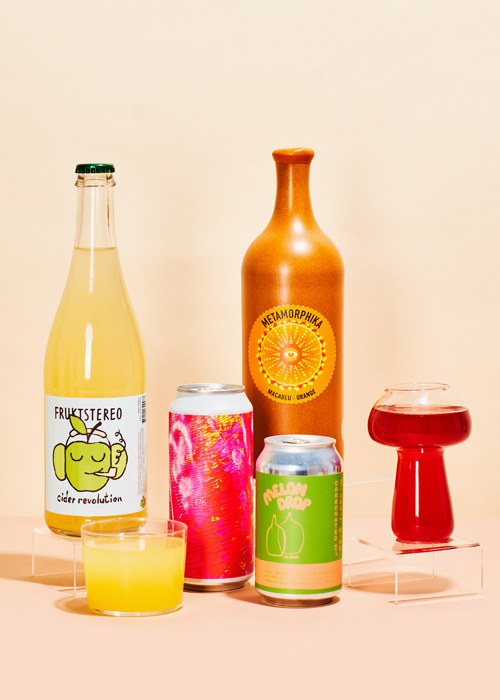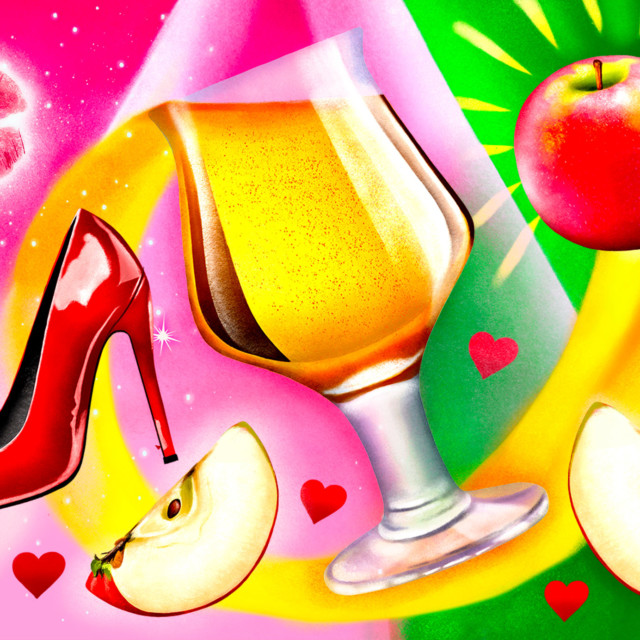Conversations about natural wine have been buzzing for the past few years, but the oft-misunderstood slice of beverage alcohol seems to (finally) be coming into its own. Plenty of drink lists, bottle shops, bars and even entire festivals are now dedicated to the naturally fermented, low-intervention, hand-picked hard grape juice. But as the segment continues to become more mainstream, drinkers dedicated to the process rather than the product may already be eyeing the next big thing.
“I think the natural wine movement has peaked. I don’t see a lot of new consumers seeking this category,” says winemaker Fin du Fresne of Chamisal Vineyards and Malene Wines in San Luis Obispo, Calif.
While not everyone shares du Fresne’s outlook (market share for categorically adjacent organic wine continues to grow, and is set to hit 1 billion bottles per year in 2022), numerous winemakers and growers around the world are shifting their focus from solely grapes to other fruits, both to diversify their products as well as to respond to shifting consumer interests. Several are turning their attention to cider apples.
When Oregon-based producer Art+Science, Cider & Wine bought the property next door to its original location in 2012, co-owner Kim Hamblin says, “we couldn’t afford to plant grapes, so we thought about apples instead and started drinking a lot of ciders to see what we liked. Because we had already been bucking traditional winemaking by embracing natural winemaking, the foray into cidermaking seemed logical.”
“The natural wine trends of low-alcohol, high-acid, and drinkable beverages perfectly describes cider,” Hamblin says.
How Does Cider Relate to Natural Wine?
Rachel Signer, a wine writer-turned-winemaker and author of “You Had Me at Pét-Nat: A Natural Wine-Soaked Memoir,” echoes the overlaps between cider and “natty” wine, especially the similarities in their production. “For natural winemakers, the approach to cider is almost the same as it is for wine,” Signer says. “The fruit should be organic and harvested by hand, and the intervention in processing should be minimal, meaning no starter yeasts, no fining or flavor additions, and no sulfites.”
To the new or casual wine drinker, it’s unlikely taste alone will provide an obvious “a-ha!” differentiation between good natural wine and “regular” wine. It’s more about the process — or lack thereof, explains Luke Schmuecker, partner and director of marketing for Shacksbury Holdings, Inc. “When describing [our products], I try to stick to the practices we use and let people make their own judgments on whether or not that fits their definition of ‘natural,’” he says.
But the benefits of minimal processing have the potential to express themselves in the final product. “The less a winery uses pesticides [and] chemical fertilizers, the more you are getting a true expression of the grape and the terroir,” says Ty Robinson, wine consultant for Surdyk’s in Minneapolis, Minn.
This relatively hands-off approach to creating a fermented beverage, coupled with the prized inconsistency of wild or foraged fruits unadulterated by additives, means drinkers seeking unique and sometimes unrepeatable flavors are likely to find similarly pleasant experiences in both natural wine and cider.
“Consumers that are interested in natural wine have an open mind when it comes to trying new beverage experiences and are willing to experiment,” Darlene Hayes, advisor for the American Cider Association and author of “Cider Cocktails – Another Bite of the Apple,” says. “This makes them open to the idea that fermented apple juice can be just as complex, nuanced, and exciting as fermented grape juice.”
Producers aren’t the only ones taking note of the shift. Events around the world that were previously wine-centric are now embracing cider as well. At the 2021 Peripheral Natural Wine Festival in Hudson, N. Y., “I’d say close to half of the drinks being showcased were cider,” says Holly Berrigan, natural wine expert and founder of Mysa Natural Wine, an online retailer. “That was the most I’ve ever seen, but [it] didn’t surprise me for the region and really highlighted how accepted cider is in the natural wine community.”
This mindset shift is occasionally necessitated by uncontrollable factors, such as natural disasters, Hamblin says. “In 2020, when a lot of Willamette Valley grapes were compromised by smoke taint, some winemakers made the jump into cider,” she says. But she believes the crossover to be fairly inevitable, even outside the complications of climate change: “The co-ferment trend has been a good segue to cider for wine drinkers.”

Wine and Cider Misconceptions
Natural wine has faced a personality crisis for years, thanks to a lack of definition as to what “natural” really means. Cider faces its own identity dilemma, thanks to its complicated categorization as wine under current federal taxation structures and labeling requirements, and simultaneous tendency to occupy shelf space next to craft beer.
“Cider gets hosed on the marketing side since it gets put in the beer cooler,” laments Andrew Jones, vice president of sales for wine grapes at Sunridge Nurseries in Bakersfield, Calif. “You would be amazed how many people ask me about how we ‘brew’ cider! Cider is just sparkling apple wine! We get lumped in with the beer scene, though, constantly.”
Misconceptions about taste abound in cider as well. Due to a relative lack of cider options in the United States — by one estimate, hard cider currently makes up 4.3 percent of the beer market share on alcohol e-commerce platform Drizly — the industry just can’t seem to shake the perception of being a sugary-sweet drink with one-dimensional flavors. “Cider has a bigger hurdle to overcome than wine, with people assuming it’s sweet and simple,” Berrigan says.
How Can Both Industries Fix Their PR Problem?
These confusing regulations concerning how and what ingredients can be listed on labels remain a challenge for natural wine and cider producers. Schmuecker describes jumping through hoops while creating Luna, a blend of Basque cider and La Crescent grapes from Vermont: “We were told by the TTB [the Alcohol and Tobacco Tax and Trade Bureau] that we legally couldn’t put any of that on the label,” he explains. “All we were allowed to say was that it was a ‘blend of apple and grape wines.’”
Hamblin echoes Schmuecker’s frustration. “Most consumers think wine is just grapes and are often surprised by how many things can be added without mentioning any of them on the label. The same is true with cider,” she says. “Marketing of natural ciders and wines could be improved by a conversation around authenticity and truth and labeling.”
But without federal labeling law updates, for the time being, producers’ hands are somewhat tied when balancing honesty in the product while complying with current regulatory standards. Still, hard cider is leveraging an innovative approach to appeal to new consumers: by taking a page out of craft beer’s handbook.
“Modern cider makers have taken a craft beer approach to marketing,” Robinson says. Cider can often be found in bottles as well as cans, he explains, which mimics the less precious grab-and-go mentality often found in craft beer and mostly eschewed by natural winemakers, who tend to stick to traditional large-format bottles. “I feel that if natural winemakers considered putting their product in a package like a 4-pack of cans, and asked that it be on the cider shelf, they would pull lots more customers,” he says.
Where Does Cider Succeed — and Natural Wine Fall Short?
Cider’s biggest strength may be in its more equitable approach to consumers, both in age and gender. Men and women both drink cider in nearly equal amounts, and cider’s relative nascence in beverage alcohol appeals to younger drinkers less committed to one segment. This ombibulous approach is more likely to be present in Gen Z drinkers, and goes even further in natural wine and cider circles.
“I would say, generally speaking, natural wine consumers are more open to trying new things, which might lead them into trying some cider — especially if it’s something that is being sold in the same place,” says Schmuecker.
For Mysa, Berrigan agrees. “People interested in natural wine are typically more excited to try new things,” she says.
With ample crossover between the two (or three) segments, Schmuecker sees opportunity. “We have friends that are brewers who are blending beer and cider, we are blending cider and wine, and there are winemakers that make their own cider on the side,” he says. “[Producers] care less and less about staying in their lane.” Will consumers follow? Can American hard cider become the next natural wine?
That may be a bit optimistic. But by taking cues from craft beer’s more easygoing marketing tendencies, embracing younger drinkers eager for something new, and with growth in local and regional brands, cider is poised to continue quietly picking up steam.
This story is a part of VP Pro, our free platform and newsletter for drinks industry professionals, covering wine, beer, liquor, and beyond. Sign up for VP Pro now!
